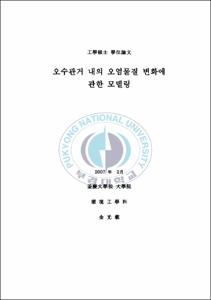오수관거 내의 오염물질 변화에 관한 모델링
- Alternative Title
- Modeling for Pollutants Variation in Sanitary Sewer
- Abstract
- Contaminats move to the wastewater treatment plant through the sewer systems. Simultaneously, while floowing, contaminants are disminished in sewer systems. This is due to the physical, chemical, and biological reactions while wastewater is flowing: the sedimentation of solid particles and the decomposition of contaminats caused by microbes living in wastewater or the pipe wall. This reactions makes the composition of raw water be changed before wastewater reaches the wastewater treatment plant, thus it influences the efficiency of wastewater treatment directly or indirectly.
In this study focused on organic matters, nutrients, and sulfides in order to predict the change of contaminants which is occurred while sewage flows in sanitary sewer. Also we simulated modeling applied to ASM1(Activated Sludge Models No. 1). When the velocity is constant at 1m/s and sewage flows for 24 hours, in the organic matter's concern, TCOD is 375mg/L at upstream and 330mg/L at downstream, showing 12% decrease. Also, SCOD is 170mg/L at upstream and 122mg/L at downstream, showing 28% decrease. To represent nutrients, TKN records 39mg/L at upstream and reduces 4mg/L, 35mg/L at downstream. In terms of sulfides, sulfer ions decrease by 60%, 12mg/L downstream from 30mg/L upstream. Consequently, hydrogen sulfide increases to 4mg/L and 2mg/L is emitted.
- Issued Date
- 2007
- Awarded Date
- 2007. 2
- Type
- Dissertation
- Publisher
- 부경대학교 대학원
- Alternative Author(s)
- Kim, Kwang-Jae
- Affiliation
- 부경대학교 대학원
- Department
- 대학원 환경공학과
- Advisor
- 이병헌
- Table Of Contents
- 제 1 장 서론 = 1
제 2 장 문헌연구 = 3
2.1 하수배제방식 = 3
2.2 하수관거의 역할 = 6
2.3 하수관거 내에서의 오염물질의 생물학적 변화 = 8
2.3.1 유기물 및 질소의 변화 = 9
2.3.2 황의 변화 = 11
2.4 활성슬러지 모델 = 14
2.4.1 활성슬러지 모델의 접근법 = 15
2.4.2 ASM1 = 17
2.4.3 ASM2, 2d = 24
2.4.4 ASM3 = 25
제 3 장 재료 및 방법 = 28
3.1 유입수 분율 = 29
3.2 적용된 매트릭스 = 31
3.3 시뮬레이터의 선택 = 35
제 4 장 결과 및 고찰 = 36
4.1 유기물의 변화 = 36
4.2 COD 소모량 = 38
4.3 유입과 유출의 유기물 성상 = 41
4.4 질소화합물의 변화 = 42
4.5 황화합물의 변화 = 45
제5장 결론 = 46
제6장 참고문헌 = 47
제7장 부록 = 50
부록. AQUASIM Program = 50
- Degree
- Master
- Files in This Item:
-
-
Download
 오수관거 내의 오염물질 변화에 관한 모델링.pdf
기타 데이터 / 1.96 MB / Adobe PDF
오수관거 내의 오염물질 변화에 관한 모델링.pdf
기타 데이터 / 1.96 MB / Adobe PDF
-
Items in Repository are protected by copyright, with all rights reserved, unless otherwise indicated.